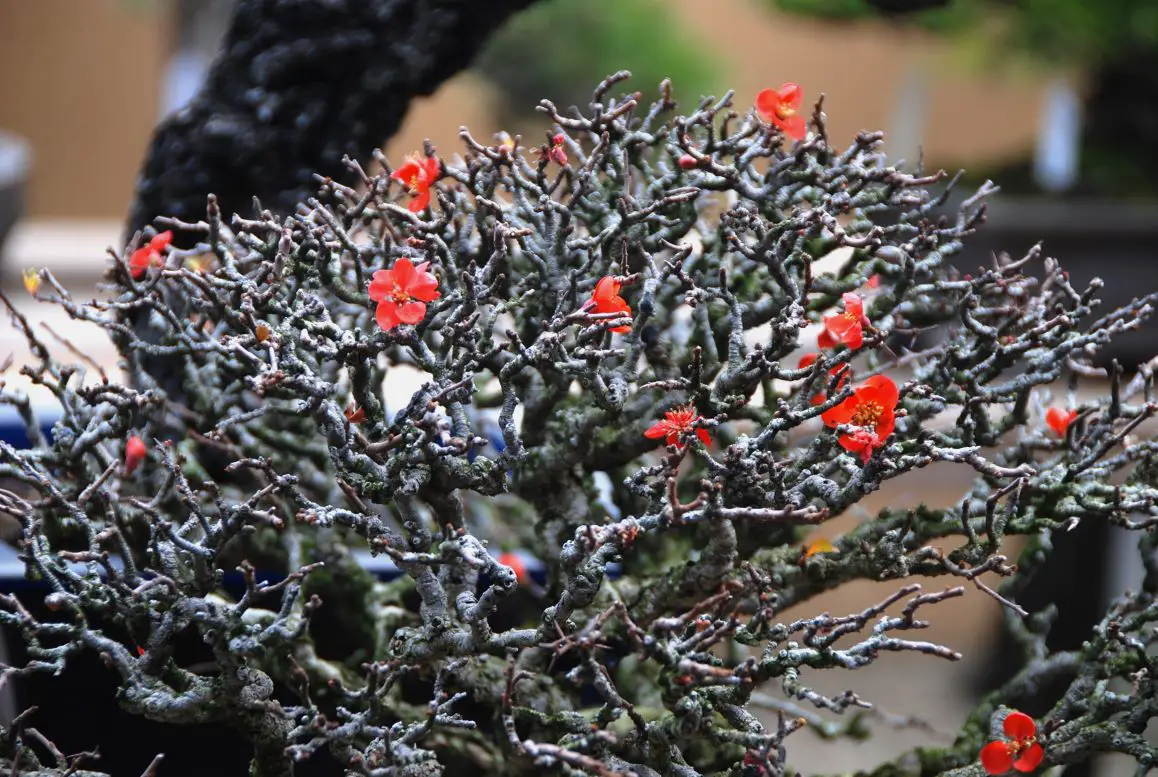Among flowering trees, azalea, wisteria and cherry blossom are the best species for flower bonsai making because they have exquisite bloom and are relatively easy to grow and be trained into bonsai.
Selecting the perfect flowering bonsai
I’ve always loved growing flowers but my exploration into the world of flowering bonsai has been a fascinating learning experience. I’ve raised a handful of them and I really liked azalea, wisteria and cherry blossom for bonsai making.
Here’s why these three varieties have captured my heart as the best flowering bonsai choices.
Azalea Bonsai
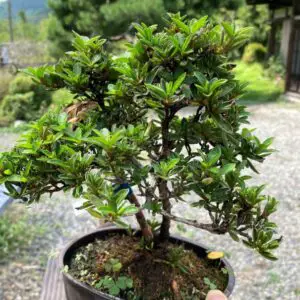
My Satsuki azalea bonsai in summer
Alluring bloom
Azalea bonsai has a certain charm that can be summed up in one simple phrase: the allure of their beautiful flowers.
Growing azalea bonsai has been a delightful discovery for me. Azaleas are very common ornamental trees alongside the roads in Japan but I haven’t paid much attention to them before I began growing bonsai.
But witnessing my azalea bonsai come to life with its bloom and new little green leaves in spring has been a rewarding experience for me. I think it will be fascinating for you as well because it really showcases nature’s beauty in miniature form right before your eyes.
Easy to bonsai
Other significant aspects that contribute to azalea bonsai’s allure include its remarkable adaptability to becoming a bonsai. Azalea responds well to hard pruning and training, enabling the creation of well-proportioned bonsai trees relatively easily.
This adaptability provides a confidence boost for those new to bonsai, especially beginners setting out on their journey to bonsai, which I know can be quite intimidating.
Rapid growth
Azalea boasts a trait that many bonsai growers find appealing: its rapid growth. This characteristic is particularly attractive to those seeking visible progress in their bonsai projects within a relatively short timeframe, which I believe a majority of people including myself.
The swift pace of growth allows you to witness tangible developments in your bonsai trees sooner, fostering a sense of accomplishment that motivates you to further invest in your bonsai endeavors.
Wisteria Bonsai
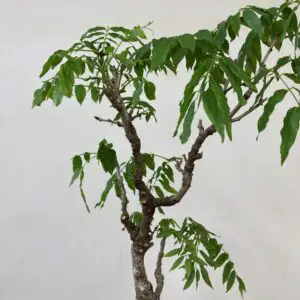
My Wisteria bonsai
Cascading beauty
The beauty of wisteria bonsai with its cascading flowers makes it the perfect flowering bonsai for everyone. The charm of wisteria bonsai flowers is their elegance, a beautiful shade of colors, cascading clusters of flowers, and a sweet but refreshing scent.
Wisteria is actually one of the trees I cherish deeply, which began in my grandparents’ garden. The memory of their lush wisteria vines draping over the pergola is distant but remains vivid.
Each time I admire the delicate blooms on my wisteria bonsai, I’m reminded of the timeless allure of nature’s beauty, encapsulated in a single bonsai tree.
Nobility in purple
The captivating color of wisteria’s purple flowers carries an air of nobility and elegance. In both Western and Eastern cultures, including Japan, the color purple has historically been associated with prestige and nobility. Wisteria’s blossoms, with their rich and regal purple tones, radiate an air of sophistication.
This connection to nobility adds to the enchantment of wisteria bonsai, making it a choice that not only brings beauty but also a touch of timeless grandeur.
Symbol of fortune and longevity
Because of its enduring longevity and robust reproductive capacity, wisteria holds significance as a symbol of fortune and longevity. This vitality enables wisteria to thrive and blossom for many years which matures gracefully over time.
Also, with proper care, wisteria’s strong fertility guarantees an abundance of blossoms which is vital for flowering bonsai trees.
Cherry Blossom Bonsai
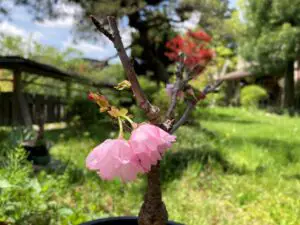
My cherry blossom bonsai
Beauty in bloom
Cherry blossoms, with their iconic pink flowers, bring an exquisite spectacle when they burst into bloom. The sight of delicate pink petals opening is nothing short of captivating.
As bonsai, cherry blossoms replicate this stunning visual with remarkable precision, allowing you to witness the ephemeral splendor of spring in your garden.
Sign of spring’s arrival
As you might know, cherry blossom is the symbol of rebirth and the beginning of spring in Japan. They mark the end of winter’s slumber and herald the renewal of life.
By nurturing cherry blossom bonsai, you can participate in this tradition of commemorating the cycle of seasons, a practice that deepens the connection between you and nature which is the core philosophy of bonsai.
Zen concept of impermanence
Cherry blossoms embody a profound philosophical concept – the Zen view of impermanence. These blossoms bloom for only a short period before gracefully falling, reminding us of the transient nature of life itself.
For me, having cherry blossom bonsai and seeing each bud’s emergence in spring after a cold winter reminds me of life’s transient moments and nature’s beauty.
Azalea bonsai
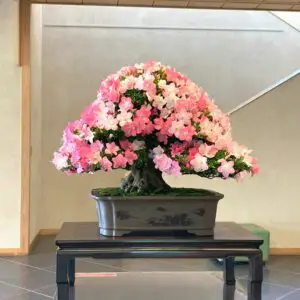
Azalea bonsai
Azaleas, belonging to the genus Rhododendron, encompass a vast array of over 1000 natural species. Most of them are native to southeast to eastern Asia, including Japan.
Azaleas exhibit remarkable diversity: tree size, leaf size, leaf shape, flower colors, bark texture and color, and flowering time.
Azaleas are among the most popular shrubs to grow all over the world and they have an uncountable number of cultivars continuously developed every year. Among those, Satsuki azalea, Miyama Kirishima Azalea, Kurume azaleas and Yama Tsutsuji or torch azalea are excellent choices for making into bonsai.
For more information about azaleas for bonsai making, the following article might be helpful.
Wisteria bonsai
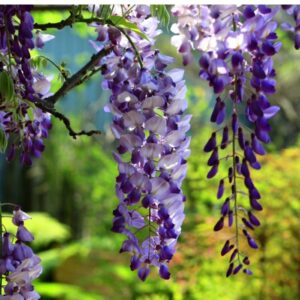
Wisteria belongs to the genus Wisteria native to Central and East Asia and North America. They are known for their pinnately compound leaves and showy, pea-like flowers that hang in long clusters.
There are 4 species in the genus Wisteria, of which 2 are native to Japan. As such, wisteria has long been celebrated in Japan and grown as bonsai trees.
If you are thinking about growing wisteria bonsai, I would recommend Japanese wisteria for bonsai making due to its exquisite and fragrant flower clusters that bloom in a variety of colors.
The following article depicts all about choosing the best wisteria for bonsai. If you are interested, please check it out.
Cherry blossom bonsai
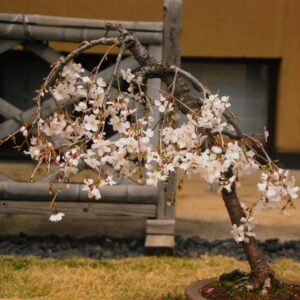
Weeping cherry bonsai
Cherry blossom is a flower of trees in the genus Prunus or the Prunus subgenus Cerasus. Cherry trees are widely distributed mainly in the Northern Hemisphere, of which 10 are native to Japan.
Cherry blossom has a cultural significance in Japan so much so that when Japanese people say “flower” (Hana), it usually means cherry blossom flowers and not other flowers that exist.
There are around 200 cultivars of cherry blossom but Fuji cherry, Japanese cherry and weeping cherry are one of the easiest ones to make into bonsai trees.
For more about cherry blossom bonsai, please read the following article.

